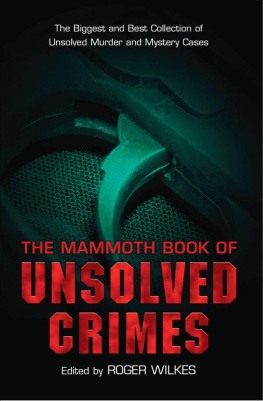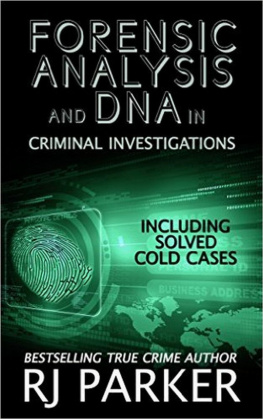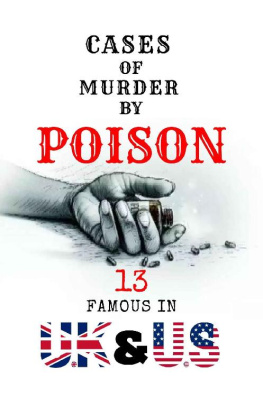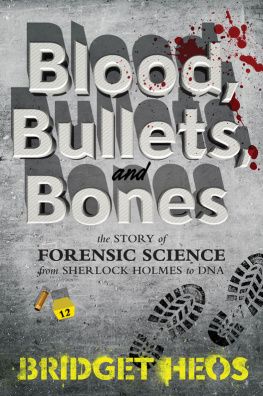| Giant Book of Murder: Real Life Cases Cracked by Forensic Science |
| Roger Wilkes |
| Vibhatsu (May 2022) |
|
| Tags: | Forensics, True, Crime, Murder, Collection |
| Forensicsttt Truettt Crimettt Murderttt Collectionttt |
This book, a collection of extraordinary cases from history and the present day, explores the story of murder and science, from the forensic dark ages to the forensic detection of the twenty-first century.
Front Flap
In 1752, a young woman named Mary Blandy put a mysterious white powder in her fathers food. At her trial for the murder of the old man, a doctor gave astonishing testimony: that he believed this powder was arsenic poison and he had performed experiments to prove it. As Mary walked up the steps to the gallows, a new science was born: the science of forensic detection.
Gathered here are extraordinary cases from history and the present day, from the first use of fingerprints in a murder trial to recent advances in genetics. Journalist and author Roger Wilkes gives a fascinating overview of famous cases covered by some of the best crime writers in history.
Title Page
The Giant Book
of
Murder
Real Life Cases Cracked by Forensic Science
Edited by
Roger Wilkes
This ePUB is
compiled & gifted to book-lovers by
Vibhatsu
India
Copyright
Constable & Robinson Ltd
3 The Lanchesters
162 Fulham Palace Road
London W6 9ER
www.constablerobinson.com
First published in the UK as
The Mammoth Book of Murder and Science by Robinson, an imprint of Constable & Robinson Ltd 2000
Last Print edition published by Magpie Books, an imprint of Constable & Robinson Ltd 2005 as Giant Book of Murder
This ePUB edition published by Vibhatsu 2022 as Giant Book of Murder: Real Life Cases Cracked by Forensic Science
Cover Design by Cadzbuddy.
Collection copyright Roger Wilkes 2000
All rights reserved. This book is sold subject to the condition that it shall not, by way of trade or otherwise, be lent, re-sold, hired out or otherwise circulated in any form of binding or cover other than that in which it is published and without a similar condition including this condition being imposed on the subsequent purchaser.
A copy of the British Library Cataloguing in Publication Data is available from the British Library
ISBN 1-84529-203-0
Printed and bound in the EU 1 3579 10 8642
Contents
(Jeremy Bamber, 1985), Jim Shelley
(Alice Crimmins, 1965), Albert Borowitz
(Mary Blandy, 1752), Horace Bleackley
(Dr Thomas Smethurst, 1859), Leslie Hale
(Hawley Harvey Crippen, 1910), Philip Willcox
(Lindy Chamberlain, 1980), Colin Wilson
(Bruno Hauptmann, 1936), Tom Zito
(Vernon Booher, 1928), Mike Gier
(Colin Pitchfork, 1986), Joseph Wambaugh
(Albert T. Patrick, 1900), Edmund Pearson
(Paddy Hill and others, 1974), Ludovic Kennedy
(Dr Sam Sheppard, 1954, Leo Grex
(The Stratton Brothers, 1905), Jurgen Thorwald
(Dr Carl Coppolino, 1965), James A. Brussel
(Richard Brinkley, 1907), C. Ainsworth Mitchell
(Wayne Boden, 1971), Clifford L. Linedecker
(Sidney Fox, 1930), Sydney Smith
(Dr Hermann Sander, 1949), David Rowan
(John George Haigh, 1949), Edgar Lustgarten
(Emile Gourbin, 1912), George Dilnot
(William Brittle, 1965), Keith Simpson
(Sarah Jane Harvey, 1960), Robert Jackson
(William Henry Podmore, 1930), Tom Tullett
(Kenneth Barlow, 1957), Percy Hoskins
(Dr Arthur Waite, 1916), John Laurence
(Harry Dobkin, 1942), Nigel Morland
(Dr Buck Ruxton, 1935), Jonathan Goodman
(Peter Griffiths, 1948), Norman Lucas
(Professor John Webster, 1849), Cleveland Amory
(John Donald Merrett, 1926), Macdonald Hastings
(Edwin Bush, 1961), Richard Jackson
(Gordon Hay, 1968), George Saunders
Introduction
In the 1930s, when the mass-circulation Sunday newspapers still savoured faintly of brown stout and chitterlings, a headline in the old Empire News proclaimed: TWO HAIRS HANGED THIS MAN! The story beneath was a startling example of how modern forensic science was finally getting the better of criminals like William Podmore, hanged (it seemed) on the evidence of two tiny hairs. Like most murderers, Podmore was a stupid and unattractive man who mistakenly believed he could get away with it. He had tried to swindle a man called Vivian Messiter, whod given him a job not knowing his history as a fraudster. When Messiter realized he was being duped, he confronted Podmore who seized a heavy hammer and smashed it down on Messiters face, killing him. Not two hairs but one, a single wiry hair from Messiters eyebrow, was later found on the hammer, but what landed Podmore on the hangmans trap was not a hair at all but a stubby, grubby pencil. A receipt book was also recovered containing records of Podmores fraudulent dealings with Messiter. The top copies had been torn out, but the pencil used to write up these transactions had left tell-tale indentations on the pages beneath. The appliance of science came when the police photographed these indented pages using special lighting. The wretched Podmore was hanged, not on the strength of microscopic hairs but by the ghosts of a few hastily-jotted names, dates and places. What helped to propel the case to public notice was the appearance at Podmores trial of the celebrated pathologist Sir Bernard Spilsbury. Ever since his spectacular debut at the Crippen trial in 1910, Spilsburys name had made news. Revered by Bench and Bar, lionised by the public, Spilsbury had earned a reputation for infallibility. His evidence, low-key and matter-of-fact, had helped convict the likes of the poisonous Major Armstrong, Patrick Mahon - the Crumbles murderer, and Norman Thome, the chicken-run killer. Although Spilsbury played only a small part in the case against Podmore, his appearance in the witness box sowed the seed of the legend about a man hanged on the strength of two hairs. The revealing lens, confided the Empire News, had focused on two tiny hairs on the weapon. Sir Bernard made up his mind very quickly. Hair human male eyebrow These two hairs pointed the killer to the police. The story had a fine Holmesian ring to it, but nothing else. As Spilsburys biographers pointed out: There was one hair, not two, on the hammer, and since it was Messiters, not Podmores and the hammer was never traced to x Podmore, a whole scalp would not have pointed the killer to the police. And while it was the kind of story that appealed to a sensationloving public, to the dour Spilsbury it was an irritating folderol. He detested personal publicity, and when he saw his carefully-weighed testimony reduced to a Sunday newspaper sideshow he was angry and ashamed. Shortly after the Podmore trial, Spilsbury got wind of a forthcoming book dealing with his career and cases. He was mortified and complained that it gave the impression of having been compiled from his personal case-notes. Spilsbury never understood the public fascination with the way in which science wages war on crime.
Criminals and scientists are old adversaries. For centuries, men of science peered through a glass darkly at the debris of murder. In the mid-eighteenth century, long before the modem tests devised by Marsh, Reinsch and Gutzeit, the detection of arsenic was a mightily inexact science. Why do you believe it to be white arsenic? Dr Anthony Addington was asked at the trial of Mary Blandy in 1752. Addington held aloft a parcel of powder, described it as milky white, like arsenic, gritty and almost insipid, and explained that although part of it floated on cold water, most sank to the bottom undissolved, again like arsenic. This thrown on red-hot iron, Dr Addington added, does not flame, but rises entirely in thick white fumes white arsenic does the same. It was another hundred years before investigators in cases of suspected arsenic poisoning discarded their red-hot irons, for the mid-point of the Victorian age marked the dawn of the Age of Detection. With a backward glance to the Blandy case (the first recorded case of murder in which scientific evidence was adduced), this is the starting point for our exploration of the story of murder and science.










